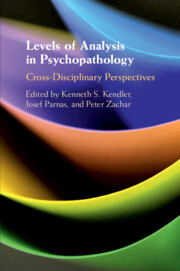Book contents
- Levels of Analysis in Psychopathology
- Advance Praise for Levels of Analysis in Psychopathology
- Levels of Analysis in Psychopathology
- Copyright page
- Contents
- Figures
- Tables
- Contributors
- Preface
- General Introduction
- Part I Neuroscience, Mechanisms, and RDoC
- Part II Phenomenology, Biological Psychology, and the Mind–Body Problem
- Section 4
- Section 5
- Section 6
- Section 7
- 19 Introduction
- 20 Challenges in the Relationships between Psychological and Biological Phenomena in Psychopathology
- 21 Non-reductionism, Eliminativism, and Modularity in RDoC: Thoughts about a Progressive Mechanistic Science
- Part III Taxonomy, Integration, and Multiple Levels of Explanation
- Index
- References
20 - Challenges in the Relationships between Psychological and Biological Phenomena in Psychopathology
from Section 7
Published online by Cambridge University Press: 02 April 2020
- Levels of Analysis in Psychopathology
- Advance Praise for Levels of Analysis in Psychopathology
- Levels of Analysis in Psychopathology
- Copyright page
- Contents
- Figures
- Tables
- Contributors
- Preface
- General Introduction
- Part I Neuroscience, Mechanisms, and RDoC
- Part II Phenomenology, Biological Psychology, and the Mind–Body Problem
- Section 4
- Section 5
- Section 6
- Section 7
- 19 Introduction
- 20 Challenges in the Relationships between Psychological and Biological Phenomena in Psychopathology
- 21 Non-reductionism, Eliminativism, and Modularity in RDoC: Thoughts about a Progressive Mechanistic Science
- Part III Taxonomy, Integration, and Multiple Levels of Explanation
- Index
- References
Summary
This chapter addresses three questions posed for the 2018 Copenhagen conference. We argue that reduction in the widely assumed sense of eliminating psychological constructs is not a feasible option in psychopathology research. We argue that the popular “levels of analysis” metaphor is more problematic than helpful. We argue that a recent movement in philosophy of science, known as the new mechanists, offers a promising alternative to the naïve biological reductionism that has driven much thinking and research on psychopathology in the Decades of the Brain. Finally, we evaluate the NIMH Research Domain Criteria (RDoC) initiative in the context of these three questions, citing key features that facilitate moving clinical research forward more quickly and more effectively than what has characterized the field for decades. RDoC avoids reductionism, fosters integration of psychological and biological constructs, methods, and data, and is well suited to the emerging research agenda in the psychopathology literature.
Keywords
- Type
- Chapter
- Information
- Levels of Analysis in PsychopathologyCross-Disciplinary Perspectives, pp. 238 - 266Publisher: Cambridge University PressPrint publication year: 2020
References
- 6
- Cited by

